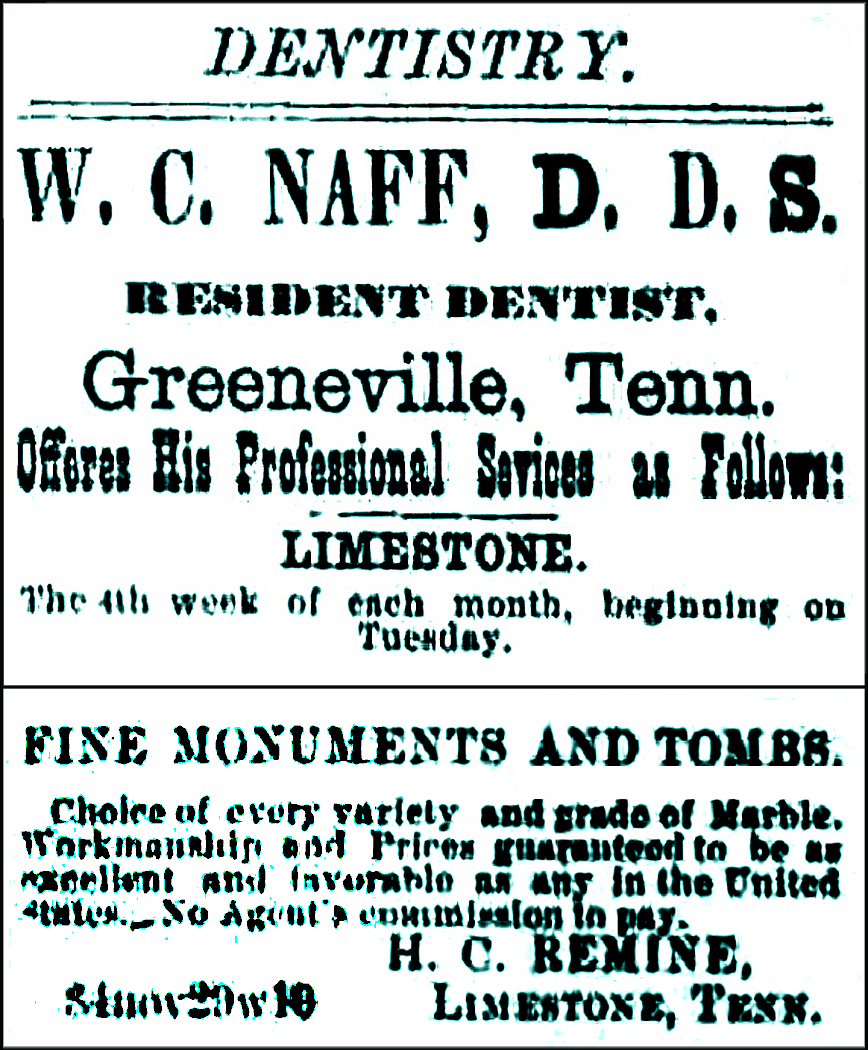In 1888, Limestone, Tennessee was described as “a lovely, healthy village, sporting mineral and sulphur springs, good farms and good people.” A newspaper reporter, identified only as “Carswell,” stopped at the Limestone Depot, which was one of many railroad stations on the East Tennessee, Virginia and Georgia Railway.
“The old brown building,” he said, “was twice shelled during the Civil War, but it's wounds were patched. The old Vet looked all the worse, as it stood in the village among the most attractive buildings of any in the State.”
Along Railroad Avenue, the business houses presented an excellent showing, being modern in style and tastefully painted with names that were admirably displayed. The rear windows looked out upon the calm waters of the Limestone, with its sandy islands and wild and tame ducks harmoniously enjoying the lovely surroundings.
The writer further noted that on the opposite side of the river, the sandy shores gave way to meadow-like grasses, and on terrace heights above cottages and mansions, aiding the other's beauty by diversity. Gothic, Elizabethan and Queen Anne cottages, divided by garden spots, a comely schoolhouse and a glistening spire, as rising between miniature hills, presented a glorious sunset picture hinting that Limestone should have had a more relaxed name.”
He further noted that the village, blest with pure running waters from streams, rills and springs, boasted that there had never been a case of sickness, which could be attributed to water stagnation. Jockey Creek joined the Limestone by the picturesque mill and two miles southwest, the famous Nola Chuckey (Nolichucky) River flowed until it vanished in the French Broad River some 50 miles distant.

Two Limestone Advertisements from 1888
“Limestone had so many healing magnesia and sulphur springs that citizens treated them with little fanfare, said Carswell. “The Magnesia Springs, owned by Ebenezer Oliver & Co., were tested by analysis to have not only the advantage of the best properties, but also as being free from lethal taste or smell. Springs around Limestone, which received no attention, could have been the site of a summer resort.
The lands in Washington County that surrounded Limestone were owned by farmers whose cultivated fields stretched to within 1200 yards of the village bridges. Their names were J.B. Klepper, Miller Brothers, Pence Brothers, Dr. Dobson, W.M. Mitchell, John A. Keebler, E.B. & M.W. Mitchell, J.0. Broyles, John D. McCray, W.J. Williams, T.J. Williams, J.A. Bayless. J.F. Nelson, D.W. Remine, H.C. Remine, G.M. and M.A. Gillispie, T.M. Brabson, David Byerly and W.B. Glaze.
Mr. C further noted that “Active work is being done by T.A. Gillispie to further the interests of the Farmer's Alliance, which is a prosperous lodge at Limestone. Two churches represent the North and South divisions of the Methodist Church. A pleasant parsonage is occupied by the Rev. George D. French, who is regarded as being a true Christian and deservedly popular gentleman. The Rev. N.S. Huffather, who, during a long ministerial life, followed the Good Sheppard also had his home in Limestone. It is noted that both congregations appear to have forgotten the antagonisms which caused a terrible war.”
The Limestone School had a very able principal in the person of Professor W. Ramsey and an able preceptress (female principal or teacher), Miss Huffaker. Although two teachers taught 125 students in the poor economy, it eventually exhibited remarkable growth, causing its future to appear beautiful and bright. The citizens had great hopes as to the town's future because mineral springs and excellent manufacturing power was backed by woods of oak, hickory and pine creating a paradise.
Carswell concluded by writing: “All passenger trains stopped at Limestone and the station had night and day operators, which indicated the railroad company had respect for the little community. They shipped cattle, mules, lumber and mineral water almost daily, while incoming freights for half a dozen stores and a thickly populated countryside profited the railroad's finances.”

Comments are closed.